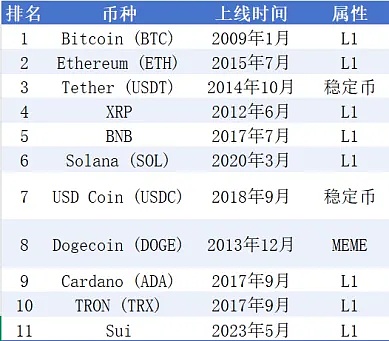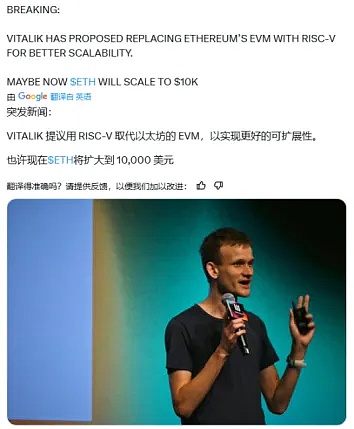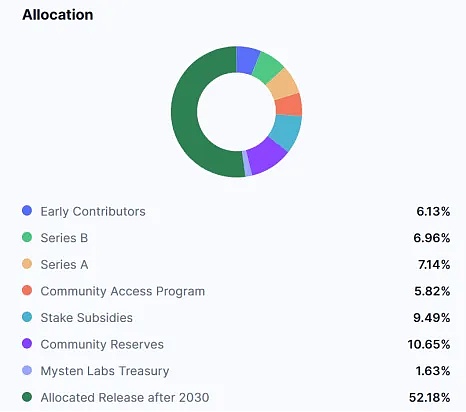The community reserves 10.65%, focusing more on the long-term construction of the Sui ecosystem, such as funding the development of DApps in the Move language, supporting community governance, or reserving funds for future expansion.

Figure 5: Sui Token Unlocking Plan
In Figure 5, you can see the unlocking plan and unlocking ratio of Sui tokens. Except for a large amount of unlocking in May 2024, the remaining tokens are gradually unlocked according to their respective allocation ratios, and the unlocking speed will gradually decrease.
At the beginning of a public chain going online, there are fewer projects and users, and a small number of tokens are released first. As the number of projects and users increases, the demand for tokens increases, and the supply gradually increases with the unlocking plan to match the demand. Its unlocking mechanism ensures that the supply and demand remain balanced and the token price is stable.
2. Construction of key projects
In some key projects, such as on-chain infrastructure or projects with large investments and slow returns, Mysten Labs officially operates and builds them.
For example:
Mysten Labs officially operates projects, such as the Deep Book order book project, which provides liquidity and rapid matching of transactions for on-chain transactions; Sui Name Service provides domain name services for Sui chains, which is more convenient for user interaction and WEB2 companies to enter; Walrus decentralized storage protocol and Seal centralized secret management service, which facilitate builders to store information and encrypt data to protect sensitive data through these two projects.
The SuiPlay0x1 handheld gaming device, because it is related to the hardware design and mass production of the device, and needs to be adapted to games on various platforms, supports WEB2+WEB3 games. It is a project with large initial investment and slow results. Without a complete ecosystem and access to WEB2 game manufacturers, it is difficult for WEB3 game companies to develop (web3 game companies are generally small in scale), so the official has taken the lead in research and development since the beginning of the SuiPlay project preparation.
3. Offline activities
Sui offline activities aim to promote Sui blockchain technology, shorten the distance between WEB3 and WEB2, attract developers, investors and partners to join the ecosystem, enhance community cohesion and enhance brand awareness. Solve traditional problems with Sui's high performance and scalability, emphasizing education, cooperation and innovation.
The activities are diverse, including global conferences, industry summits, community gatherings, technical workshops and hackathons. The content covers Sui technology progress, Move language education, ecological project display, industry trend discussion and developer practice, helping participants to gain a deep understanding of Sui, learn development and establish connections. The activities cover North America, Asia and Europe and other regions to jointly promote the development of Sui ecology.

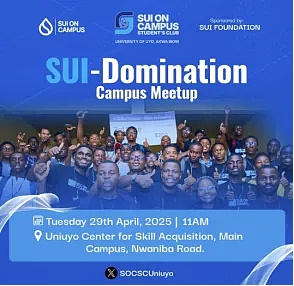
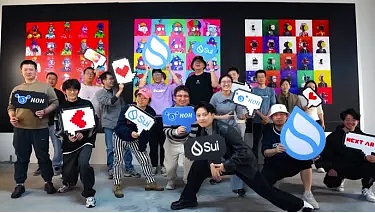
Compliance Solutions
Sui Blockchain has taken a number of measures to ensure compliance with regulatory requirements, including Anti-Money Laundering (AML) and other legal compliance. However, Sui as a decentralized blockchain itself does not directly enforce AML or KYC, but it provides the necessary tools and infrastructure for projects built on the platform to meet regulatory standards.
1. Compliance and Legal Requirements
According to Sui Terms of Service, users must comply with all applicable laws when using the platform, including AML, anti-terrorist financing and sanctions regulations. The terms explicitly prohibit engaging in activities that violate the law, such as money laundering, terrorist financing, or violations of OFAC sanctions. Users are responsible for their own tax compliance, including maintaining records and reporting transactions to tax authorities, and Sui may report user activities as required by law to ensure transparency.
2. Partner Support
Sui's decentralized nature makes it difficult to implement AML/KYC directly like traditional financial institutions, but by providing transparent transaction records and partner tools, it supports projects to meet regulatory needs. For example, Sui Blockchain, through its partnership with Ant Digital, uses its ZAN platform to provide KYC and AML tools to support compliant tokenization of real-world assets (RWA). ZAN, as Sui's RPC node operator, accesses Sui's infrastructure. This means that ZAN's tools can communicate seamlessly with Sui's blockchain network, enhancing its scalability and security.
In addition, Sui's terms of service allow funds to be frozen or restricted to meet legal requirements and ensure overall compliance. (If $1.46 billion is stolen from Bybit on the Sui chain, the stolen money may be frozen according to the terms).
3. Compliance at the project level
Sui itself does not enforce KYC (know your customer) or AML (anti-money laundering) because it is a decentralized blockchain network. Research shows that Sui DeFi tools can usually be used by simply connecting to a Sui wallet, without KYC, bank card or email registration. However, when it comes to fiat currency deposits or withdrawals, such as selling Sui tokens through exchanges, multi-level KYC verification may be triggered. This shows that compliance is mainly achieved by the project or third parties themselves, and Sui provides support tools rather than direct enforcement.
Specific Compliance Measures
Sui Chain improves compliance and isolates compliance risks through on-chain infrastructure support, compliance partners, project review, etc.
1. Enhance compliance through infrastructure support
Use innovative technologies to enhance compliance. For example, Walrus, Seal and zkLogin have significantly enhanced compliance with the EU General Data Protection Regulation (GDPR). GDPR is an important data protection regulation of the European Union that aims to protect the personal data privacy of EU citizens and requires organizations to comply with strict rules in data collection, processing and storage, including data minimization, purpose limitation, storage limitation, integrity and confidentiality, and ensuring the rights of data subjects (such as access, correction, deletion, etc.).
Walrus is a decentralized storage protocol designed for processing large binary files (blobs). It allows sensitive personal data to be stored on independent sub-chains for quick deletion, meeting the GDPR's "right to be forgotten" (Article17GDPR).
Provides secure storage and access control for sensitive data. Seal ensures that personal data is protected during storage and processing through its security mechanism, in line with GDPR's requirements for data security and privacy.
zkLogin is a native feature of Sui that allows users to log in to decentralized applications (DApps) using familiar Web2 credentials (such as Google, Facebook) without having to manage private keys or seed phrases. By not disclosing user credentials and using zero-knowledge proofs, it supports the GDPR's data minimization principle (Article5GDPR). It reduces the amount of personal data stored on the chain while ensuring that user privacy is protected. In addition, the design of zkLogin also avoids the complexity of traditional private key management and reduces the risk of data leakage.
2. Cooperation with third parties
Sui Chain cooperates with third parties such as Chainalysis to improve compliance through its community-driven Sui Guardian program. Sui Guardian tracks scams and phishing websites, and Chainalysis's analysis tools are able to monitor and analyze on-chain transactions, identifying addresses or patterns associated with known illegal activities. By analyzing transaction patterns, Chainalysis can identify potential victims of phishing attacks and help exchanges and users take preventive measures. This helps Sui comply with AML and KYC regulations worldwide, such as the European Union's Fifth Anti-Money Laundering Directive (5AMLD) and the United States' Bank Secrecy Act (BSA).
3. Project self-discipline
Through various tools, developers are helped to self-discipline and ensure compliance, such as for geographic restrictions. For example, Sui has partnered with Netki to launch DeFi Sentinel, a compliance oracle that provides developers with automated compliance tools, including real-time KYC/AML (know your customer/anti-money laundering), wallet screening, and financial transaction monitoring. These tools can help dApp verify the location of users and ensure that only users in compliant regions can access services.
For example, the Doubleup gambling project is only open to users in gambling compliant regions.
4. Risk Isolation
In the blockchain ecosystem, public chains usually provide services as the basic layer, while application development is mainly completed by the project party, including Defi, DApp, DePin, etc. Users interact through smart contracts written by the project party, and the stakeholders are mainly the project party and users (contract participants). At present, the parties to most legal disputes and judicial precedents are the project party and its participants. Unless there are major vulnerabilities in the public chain that directly cause user losses, the public chain is rarely listed as a defendant.
For example, Sui recently announced a partnership with xMoney and xPortal to launch a digital Mastercard that supports SUI tokens in Europe. As a technical platform, Sui itself is mainly responsible for the construction of infrastructure and asset ecology. The payment side is undertaken by the licensed institution xMoney, and the application side user experience is managed by xPortal.
Analysis of Sui Chain's Compliance Path
From the practice of Sui Chain, we can see that compliance has been taken as an important development direction since the beginning of the design, and has been integrated into the top-level design of the public chain.
The layout of the public chain should start from the overall perspective and adapt to the future development direction from the underlying logic. As a public chain project, development planning cannot be done from the perspective of a single project. Diverse application scenarios and development trends should be considered and the layout should be made in advance.
Governing the chain is like governing a country. Only when there is complete infrastructure construction on the chain, taking the lead in developing high-investment projects, and reasonably allocating incentives, can more developers and users be attracted, and a rich chain ecology can be gradually developed.
Conclusion
As a rising star in the public chain field, Sui Chain has successfully found a balance between compliance and development through its unique technical architecture and well-thought-out operational strategy.
Compliance has been integrated into the top-level architecture since its design, which not only meets the requirements of global supervision, but also builds a vibrant and robust ecosystem through community incentives, key project construction and offline activities. Its specific measures at the user compliance, partner support and project level, such as cooperating with third parties to provide KYC/AML tools and using innovative technologies to support GDPR compliance, demonstrate its foresight and execution in responding to regulatory challenges.
The practice of Sui Chain proves that compliance is not only a necessary condition for public chains to cope with external pressure, but also a key bridge to promote the deep integration of blockchain technology and the real world. Compliance is not only for regulatory services, but also for users on the chain and for everyone in the real world.
Although the Web3 world advocates "The code is the law", the excessive jungle law is regulated by various countries and rejected by mainstream society, which will make Web3 stay in the virtual world. Only by compliance can we truly cross the boundary between virtual and reality, bring safer and more convenient services to global users, and unleash its revolutionary potential.
Considering how to combine Web3 with the real world is the starting point and end point of compliance.
 Brian
Brian


